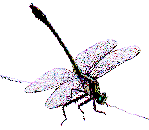DRAGONFLY
(Order Odonata)
Judi Manning
 Dragonflies
have always intrigued me. As a youngster, when the fish were not biting, the
dragonflies would be there to entertain me as they sat on the fish pole, on my
knee, or on my arm. The dragonfly is not a fly and is named for its fierce jaws.
Dragonflies
have always intrigued me. As a youngster, when the fish were not biting, the
dragonflies would be there to entertain me as they sat on the fish pole, on my
knee, or on my arm. The dragonfly is not a fly and is named for its fierce jaws.
In the Carboniferous period, over 300 million years ago, before dinosaurs roamed
the earth, the dragonfly inhabited Earth. The oldest dragonfly specimen is a
fossilized wing found in a coal field in England. The largest known dragonfly
was called Meganeura, because it had a wingspan from tip to tip of 24"! This
dragonfly was one of the first insects to fly and was one of the largest insects
known to exist! Today, there are over 5,000 identified species; 450 in No.
America. The largest dragonfly is found in South America and has a wingspan of
just over 7 inches.
Dragonflies hold their wings two different ways: extended laterally when at rest
"heavy bodied dragonfly" (Anisoptera) [true dragonfly] or those that fold their
wings together above their back as in the "slender damselflies" (Zygoptera).
They have two sets of wings and can move each set in a different direction. When
the front wings go up, the back wings go down. These wings also enable them to
hover, fly backward, turn around quickly in mid-air and land in an instant. The
dragonfly beats its wings 20-30 times per second.
These large, slender insects typically ¾" - 1" long, have evolved as specialized
hunters. They depend on their eyes for hunting food and can focus on objects 20
feet away. The eyes are enormous -- ½ circles composed of two sections: one
looks up for danger; one looks down for prey. Each eye is made up of up to
28,000 lenses which touch or nearly touch at the top of the large head. These
eyes allow it to see better than any other insect. Always hunting for food, they
scoop their prey into a basket formed by their spiny out-spread legs while in
flight. It then eats its prey by ripping pieces off and chewing them while
flying. The dragonfly eats up to 600 insects a day. Other than catching food
with its legs, it can only use them to cling to objects such as twigs and
grasses while resting. It cannot walk. Dragonflies, a/k/a darning flies, do not
bite and cannot "sew anything". They are sometimes called mosquito hawk because
they eat so many mosquitoes. They also eat gnats and flies.
The male of some species stake out a territory for one hour to several days and
defend it from all other males, mating with every female that enters its
territory. They mate in the air forming a wheel pattern. The eggs of some
species are laid directly into the water laying several thousand eggs per
episode. In some species, both the male and female become submerged to lay the
eggs. Some species lay their eggs inside a plant or in the mud on the bank of
the water laying approx. 100 eggs a day. Each egg hatches into a squat, dingy
brown nymph with six walking legs, called a naiad (water nymph) which is
predaceous. The nymph hides under leaves, sticks, stones or under the sand with
only its eyes showing. The nymph does not chase its prey; it just waits for the
prey to come close. It is sometimes several weeks between meals. To capture its
prey, its hinged bottom lip shoots out and it grasps the prey with its powerful
pinchers located at the outer edge of the lips. After it is finished eating, the
lip is folded back and a portion of it covers the naiad’s face, like a mask. Its
dinner menu includes tadpoles, small fish, mosquito larva, other dragonfly
nymphs, and water bugs, devouring its own weight at one sitting.
The nymph breathes by sucking water into a special gill chamber in its hind
quarters. After enough oxygen has been absorbed, the water is shot back out so
it does not have to come up for air like most pond insects. It also forcefully
shoots this water from its anus to escape predators in fast jet-propulsion
fashion.
The skin is molted as it grows. One evening up to five years later, on its final
molt, it crawls out of the water and attaches itself to a twig. Its body begins
to swell and the skin splits. Up to four hours later, it stretches out its wings
and pumps blood into them, making them stiff and strong. The sun dries and
hardens the dragonfly’s body and wings. Up to one month later, the bodies reach
the maximum colors of electric-blue, blood-red or acid-green. The wings look
like hundreds of diamonds in the sunshine. After such a long wait as a nymph, an
adult dragonfly only lives for three months.
Dragonflies are studied by ecologists to determine changes in the environment
because they are at the top of their food chain at both stages of their life.
The US Air Force has spent thousands of dollars trying to understand their 60
MPH speeds and lightning stops and starts and the instant right-angle turns.
If you want to see some giant (10 foot dragonflies), take a trip to the New York
State Museum before December 29, where they have a giant robotics model display.
The mechanized creatures include a praying mantis, beetle and a carpenter ant.
You can get more information from The Dragonfly Society of the Americas at
http://www.dragonfly.org. They have many links to other web sites and lots of
interesting info on the life and times of dragonflies.
References:
Dragonfly, Microsoft Encarta, 1993
Dragon Flies, Deborah Churchman, Ranger Rick, 5/93, Pgs 16-19
Insects Get Larger Than Life to Show Their Big Role, Genaro C. Armas, GRPress
8/4/96, A11
Lord of the Dragonflies, David Van Biema, Life, Feb., 1993, Pgs. 62-64
Zoom Along, Dragonfly, Judy Ann Harvey, Cricket, July, 1994, Pgs 35-37
The Audubon Society Field Guide to N.American Insects & Spiders, Pg. 363
The Life of Insects, V.B. Wigglesworth.
Double Life, The Economist, January 30k, 1993
Insects - Hunters and Trappers, Ross E. Hutchins, Rand McNally
Dragonflies, by Terry Morse, 11/11/95, James Cook University,
Copyright © 1997 Owashtanong Islands Audubon Society.
All rights reserved.

